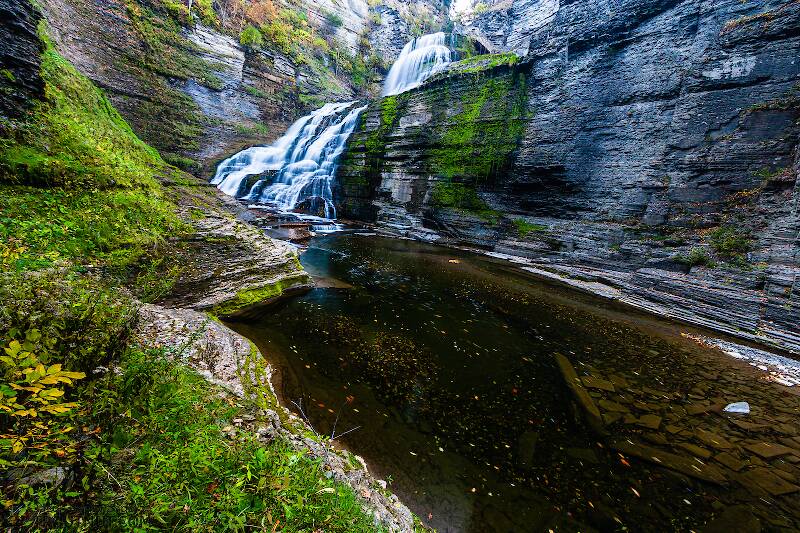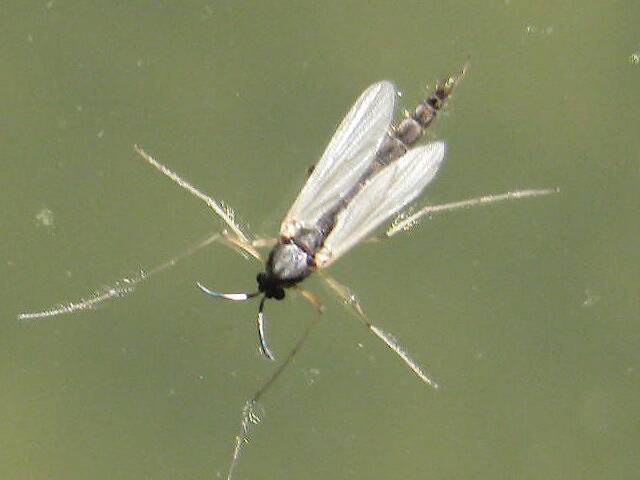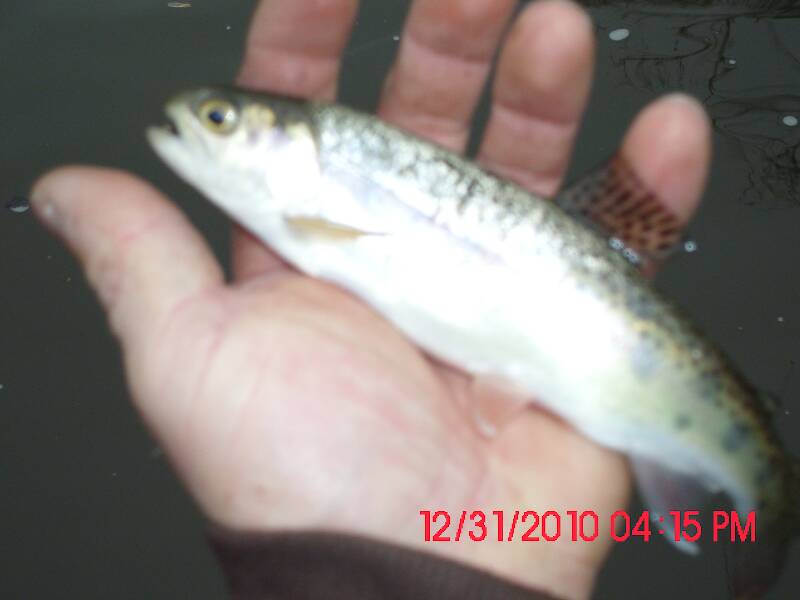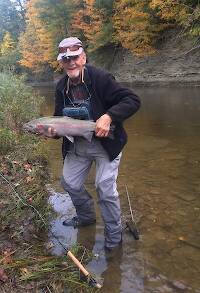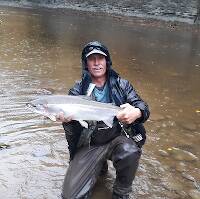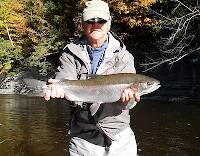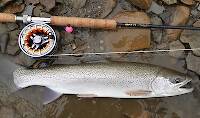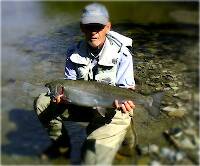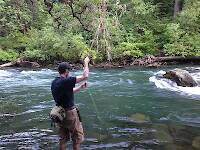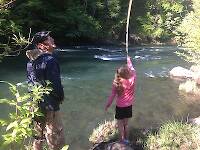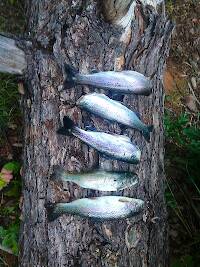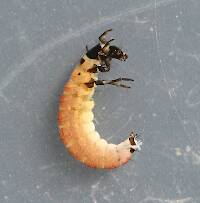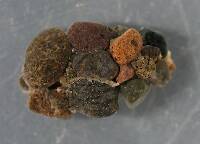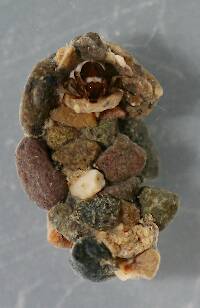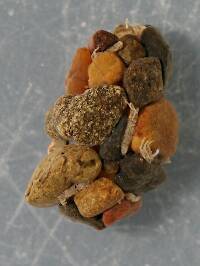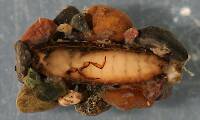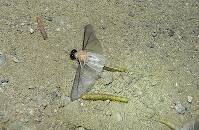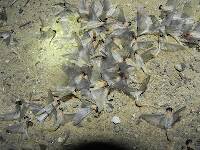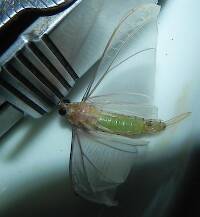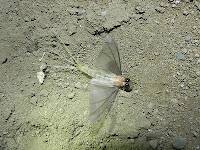
Hex Mayflies
Hexagenia limbata
The famous nocturnal Hex hatch of the Midwest (and a few other lucky locations) stirs to the surface mythically large brown trout that only touch streamers for the rest of the year.
Featured on the forum


Troutnut is a project started in 2003 by salmonid ecologist Jason "Troutnut" Neuswanger to help anglers and
fly tyers unabashedly embrace the entomological side of the sport. Learn more about Troutnut or
support the project for an enhanced experience here.
Bcvizina on Feb 5, 2011February 5th, 2011, 6:37 pm EST
The idea that Jason had for putting common names next to the correct latin identification for each aquatic species on this website. I was wondering if somebody wanted to help put together a same kind of list for stream reading terminology.
After reading some books, I'm still quite vague as to the meaning of every type of stream terminology, and it's seems some are loosely interchanged. Run, riffle, glide, eddy, chute.... the list seems to go on and on. I'm trying to make a little list for personal reference, because nobody else has done it clear enough for me to understand.
I also want to put on a note that if any word is deemed unnecessary and redundant should be omitted.
I'm more interested in the bug behavior part of entomology, and I think that having a shared foundation of stream reading terminology would be beneficial to analyzing the life cycles of aquatic insects and sharing these observations among anglers. That said, I would like to start with runs and riffles because they are often referred to on this site. Is there any need to go into further classification for trying to share witnessed patterns with behavior?
After reading some books, I'm still quite vague as to the meaning of every type of stream terminology, and it's seems some are loosely interchanged. Run, riffle, glide, eddy, chute.... the list seems to go on and on. I'm trying to make a little list for personal reference, because nobody else has done it clear enough for me to understand.
I also want to put on a note that if any word is deemed unnecessary and redundant should be omitted.
I'm more interested in the bug behavior part of entomology, and I think that having a shared foundation of stream reading terminology would be beneficial to analyzing the life cycles of aquatic insects and sharing these observations among anglers. That said, I would like to start with runs and riffles because they are often referred to on this site. Is there any need to go into further classification for trying to share witnessed patterns with behavior?
PaulRoberts on Feb 6, 2011February 6th, 2011, 6:35 am EST
An accurate glossary is critical in my mind. Anglers do things that most people don't, and language develops around that. Problem is we are all re-inventing the wheel, or adding to it. Often, I find, words are coined for things that are not well understood. As we learn more we hone that language.
Falsifly on Feb 6, 2011February 6th, 2011, 7:20 am EST
Maybe a sticky topic like “WORD of the DAY”
Falsifly
When asked what I just caught that monster on I showed him. He put on his magnifiers and said, "I can't believe they can see that."
When asked what I just caught that monster on I showed him. He put on his magnifiers and said, "I can't believe they can see that."
Creno on Feb 6, 2011February 6th, 2011, 10:18 am EST
The only "definition" I know is the difference between a creek and a crick - a crick has a tire in it.
If you really want to get into stream morphology and habitat terminology start with Dave Rosgen's stuff - you can subdivide that as far as you want.
http://www.wildlandhydrology.com/
creno
If you really want to get into stream morphology and habitat terminology start with Dave Rosgen's stuff - you can subdivide that as far as you want.
http://www.wildlandhydrology.com/
creno
Bcvizina on Feb 6, 2011February 6th, 2011, 11:44 am EST
I think word of the day would be a good idea. Everyone could give their two cents worth for any given word.
Benjlan on Feb 6, 2011February 6th, 2011, 12:31 pm EST
Thats a good one crick has a tire in it.
Jmd123 on Feb 6, 2011February 6th, 2011, 2:51 pm EST
Ben, here's a starter for ya:
RIFFLE - an area with substantial turbulence of flow, generally visible on the water's surface. Riffles are typically found in shallow areas with gravel or cobble bottoms. The gravel and/or cobble forms lots of spaces for aquatic critters to hide, hence they hold a lot of food for trout, which like to sit just downstream from them to wait for critters that loose their grip and drift down with the current - easy prey.
RUN - also known as a glide, it is an area with fairly smooth flow (low to no turbulence) that is intermediate and even in depth. Bottoms can be cobble, gravel, or sand, or in some cases silt (if the current isn't too swift) or clay. Runs or glides can hold fish, especially if they are below riffles, but usually fish will only be there if there are obstructions to provide cover and breaks from the curent, e.g. rocks or sunken logs. Silt bottoms can provide homes for burrowing critters like some mayflies (e.g., Hexagenia), but they are more commonly found in...
POOLS - area of slack water with very slow to sometimes almost non-existent currents, generally the deepest areas in streams with bottoms again varying from cobble to clay but often holding considerable quantities of silt. BIG trout like to hide at the bottoms of pools, as the water depth itself provides cover but especially if there is other cover in the form of rocks or sunken logs. Pools also provide different foods such as crayfish, insects preferring slower currents and silt bottoms, and sometimes smaller fish as well. Pools are sometimes found at the bases of waterfalls or rapids, and these types of pools often hold lots of fish waiting for food to get washed down from above by the swift currents of the falls or rapids.
EDDY - an area, most often found along the edge of a pool, where the current reverses itself and flows in the opposite direction. Eddies are often good places to fish because the reverse currents bring food to areas where fish don't have to fight the faster flows, hiding along the bank beneath logs and in undercuts (where the current has cut beneath the bank).
CHUTE - a narrow area where water is funneled through at a higher speed. Sometimes fish will hang downstream or even in a chute if there is a current break behind which they can hide, as the food gets concentrated by the funneling effect.
Does this help? I hope so.
Jonathon
RIFFLE - an area with substantial turbulence of flow, generally visible on the water's surface. Riffles are typically found in shallow areas with gravel or cobble bottoms. The gravel and/or cobble forms lots of spaces for aquatic critters to hide, hence they hold a lot of food for trout, which like to sit just downstream from them to wait for critters that loose their grip and drift down with the current - easy prey.
RUN - also known as a glide, it is an area with fairly smooth flow (low to no turbulence) that is intermediate and even in depth. Bottoms can be cobble, gravel, or sand, or in some cases silt (if the current isn't too swift) or clay. Runs or glides can hold fish, especially if they are below riffles, but usually fish will only be there if there are obstructions to provide cover and breaks from the curent, e.g. rocks or sunken logs. Silt bottoms can provide homes for burrowing critters like some mayflies (e.g., Hexagenia), but they are more commonly found in...
POOLS - area of slack water with very slow to sometimes almost non-existent currents, generally the deepest areas in streams with bottoms again varying from cobble to clay but often holding considerable quantities of silt. BIG trout like to hide at the bottoms of pools, as the water depth itself provides cover but especially if there is other cover in the form of rocks or sunken logs. Pools also provide different foods such as crayfish, insects preferring slower currents and silt bottoms, and sometimes smaller fish as well. Pools are sometimes found at the bases of waterfalls or rapids, and these types of pools often hold lots of fish waiting for food to get washed down from above by the swift currents of the falls or rapids.
EDDY - an area, most often found along the edge of a pool, where the current reverses itself and flows in the opposite direction. Eddies are often good places to fish because the reverse currents bring food to areas where fish don't have to fight the faster flows, hiding along the bank beneath logs and in undercuts (where the current has cut beneath the bank).
CHUTE - a narrow area where water is funneled through at a higher speed. Sometimes fish will hang downstream or even in a chute if there is a current break behind which they can hide, as the food gets concentrated by the funneling effect.
Does this help? I hope so.
Jonathon
No matter how big the one you just caught is, there's always a bigger one out there somewhere...
Benjlan on Feb 6, 2011February 6th, 2011, 3:56 pm EST
Jonathon,
That looks good to me. You should be a writer for the dictionary people. How's the new job?
Ben
That looks good to me. You should be a writer for the dictionary people. How's the new job?
Ben
Jmd123 on Feb 6, 2011February 6th, 2011, 4:06 pm EST
The new, actually a revival of the old, job goes well. Lots of bugs to identify! More tomorrow, it's just about my bedtime now that I'm back amongst the employed...
Jonathon
Jonathon
No matter how big the one you just caught is, there's always a bigger one out there somewhere...
Oldredbarn on Feb 7, 2011February 7th, 2011, 3:36 am EST
Jonathon,
Nice post. I think that should be very helpful to Brent...There are many books out there that relate, especially for mayflies, where certain species like to live...Some swim, some crawl, some cling etc...If one can learn and relate the behavior of the little critters to where they like to hang out and can spot these different areas of a stream, well I think you are more than half way there. Otherwise you are pounding the water a bit.
You forgot the wader filling hole...You know, you are walking along and think everythings ok and you take that next step and oops! I think my waders are filling up...The Little Manistee, for example, is filled with such..."Hey! That doesn't look that deep...Damn!" Then the fast peddle, shuffle, and prayer that you will make it out of there to higher ground. While you are trying to save your life you realize you also spooked a very large "hold-over" who was hunkered down in that hole...You really don't think about him, or that he was as long as your arm, until you are in a safe place and then you kind of scold yourself a bit and hope no one saw all this from shore.
Then there is the wader boot stealing elodea patch growing from the muck mound but thats for another time...It looked very solid from the surface...If one is honest this can be a little frightening and another embarassment when you notice just how much silt etc you are kicking downstream as you try to extract yourself...As your boot is coming free there are all these bubbles coming to the surface...I've heard that this comes from a million Hex nymphs laughing at you...This could be an old anglers tale though...Not really sure.
Spence
Nice post. I think that should be very helpful to Brent...There are many books out there that relate, especially for mayflies, where certain species like to live...Some swim, some crawl, some cling etc...If one can learn and relate the behavior of the little critters to where they like to hang out and can spot these different areas of a stream, well I think you are more than half way there. Otherwise you are pounding the water a bit.
You forgot the wader filling hole...You know, you are walking along and think everythings ok and you take that next step and oops! I think my waders are filling up...The Little Manistee, for example, is filled with such..."Hey! That doesn't look that deep...Damn!" Then the fast peddle, shuffle, and prayer that you will make it out of there to higher ground. While you are trying to save your life you realize you also spooked a very large "hold-over" who was hunkered down in that hole...You really don't think about him, or that he was as long as your arm, until you are in a safe place and then you kind of scold yourself a bit and hope no one saw all this from shore.
Then there is the wader boot stealing elodea patch growing from the muck mound but thats for another time...It looked very solid from the surface...If one is honest this can be a little frightening and another embarassment when you notice just how much silt etc you are kicking downstream as you try to extract yourself...As your boot is coming free there are all these bubbles coming to the surface...I've heard that this comes from a million Hex nymphs laughing at you...This could be an old anglers tale though...Not really sure.
Spence
"Even when my best efforts fail it's a satisfying challenge, and that, after all, is the essence of fly fishing." -Chauncy Lively
"Envy not the man who lives beside the river, but the man the river flows through." Joseph T Heywood
"Envy not the man who lives beside the river, but the man the river flows through." Joseph T Heywood
Jmd123 on Feb 7, 2011February 7th, 2011, 5:21 am EST
BTW, I meant to say Brent, as well as Ben. Brent, when we hit the streams together this summer, I will be sure to give you a few lessons on habitat & ecology if you so desire.
Jonathon
Jonathon
No matter how big the one you just caught is, there's always a bigger one out there somewhere...
PaulRoberts on Feb 7, 2011February 7th, 2011, 10:09 am EST
Rosgen's the man. But anglers need to meld the physics with biology/ecology. For instance, Rosgen would likely never use the term "drift lane" or "foraging site".
Bcvizina on Feb 7, 2011February 7th, 2011, 2:23 pm EST
Alright, that's really all that I wanted to know. Just a clarification of how I would describe a part of a river to someone.
I'd be happy to take some lessons, I like nature and the outdoors, but I'm not a biology major.
And Spence, I hate the spots on or near the bank that are just slick clay, where your toes slip out and your rod tip goes flying without caution... always a scary situation.
I'd be happy to take some lessons, I like nature and the outdoors, but I'm not a biology major.
And Spence, I hate the spots on or near the bank that are just slick clay, where your toes slip out and your rod tip goes flying without caution... always a scary situation.
Entoman on Feb 7, 2011February 7th, 2011, 9:26 pm EST
Hi Bcvizina,
Your four paragraph post pretty much encapsulates the challenge and fascination of fly fishing. Reading the water, technique, presentation, fly selection, and fish handling are what it's all about. Those are the essential skills you will acquire over time.
Learning all you can about bugs by reading is a good thing. As far as "reading the water" goes I think once you've got the basics down from Jonathon's post, it's time to do more fishing, preferably with a good angler that can "mentor" you or with a guide at least a few times. After explaining you're needs, ask the guide service to set you up with the right fit. Your learning curve will skyrocket. There are several books on the topic, but I'm not a big fan of them. The reason is the only people that really understand what's trying to be said don't need them. Remember what we're talking about is as much art as science, Far better are videos. There are several that do an excellent job. The old 3M/SA tapes with Gary Borger and others are examples of video with excellent instruction along these lines. I think you will find them more helpful than reading or putting together a list. The old saying "A picture is worth a thousand words" is very fitting in this regard.
The terms used to describe the water will be better understood and become clearer to you the more you do those things. I don't presume to know what you've read already, but it's fair to say that when the authors were describing a bit of water, they probably weren't using interchangeable or superfluous terminology. In addition to many adjectives applicable to "pool, run, eddy" that convey a deeper understanding, there are also a host of others that describe different kinds of water. All of them bring up fairly distinct mental images for experienced anglers. Rest assured they will for you in time as well. It's like this: If I'm trying to describe Jennifer Aniston to you and you've never heard of her, it doesn't matter how many adjectives I use, you are not going to know what she looks like. But if you've seen her before, well, that's a different story. Pretty sure the right mental image will come to you fairly quickly, right?
Best regards,
Kurt
Your four paragraph post pretty much encapsulates the challenge and fascination of fly fishing. Reading the water, technique, presentation, fly selection, and fish handling are what it's all about. Those are the essential skills you will acquire over time.
Learning all you can about bugs by reading is a good thing. As far as "reading the water" goes I think once you've got the basics down from Jonathon's post, it's time to do more fishing, preferably with a good angler that can "mentor" you or with a guide at least a few times. After explaining you're needs, ask the guide service to set you up with the right fit. Your learning curve will skyrocket. There are several books on the topic, but I'm not a big fan of them. The reason is the only people that really understand what's trying to be said don't need them. Remember what we're talking about is as much art as science, Far better are videos. There are several that do an excellent job. The old 3M/SA tapes with Gary Borger and others are examples of video with excellent instruction along these lines. I think you will find them more helpful than reading or putting together a list. The old saying "A picture is worth a thousand words" is very fitting in this regard.
The terms used to describe the water will be better understood and become clearer to you the more you do those things. I don't presume to know what you've read already, but it's fair to say that when the authors were describing a bit of water, they probably weren't using interchangeable or superfluous terminology. In addition to many adjectives applicable to "pool, run, eddy" that convey a deeper understanding, there are also a host of others that describe different kinds of water. All of them bring up fairly distinct mental images for experienced anglers. Rest assured they will for you in time as well. It's like this: If I'm trying to describe Jennifer Aniston to you and you've never heard of her, it doesn't matter how many adjectives I use, you are not going to know what she looks like. But if you've seen her before, well, that's a different story. Pretty sure the right mental image will come to you fairly quickly, right?
Best regards,
Kurt
"It's not that I find fishing so important, it's just that I find all other endeavors of Man equally unimportant... And not nearly as much fun!" Robert Traver, Anatomy of a Fisherman
Oldredbarn on Feb 8, 2011February 8th, 2011, 3:17 am EST
And Spence, I hate the spots on or near the bank that are just slick clay, where your toes slip out and your rod tip goes flying without caution... always a scary situation.
The Au Sable has its share of clay marl patches and they can be really slick. The one nice thing about them is they are very light and if you are careful at night you usually can see them and avoid them. If you don't and find yourself in the middle of one some evening...Well good luck to you and lets hope the "river gods" are smiling down upon you or else it could be soaker time.
Rusty Gates used to tell me that his father would take a pinch or so of the clay and apply it along his leader and tippet to cut down a bit on its shine...
Spence
"Even when my best efforts fail it's a satisfying challenge, and that, after all, is the essence of fly fishing." -Chauncy Lively
"Envy not the man who lives beside the river, but the man the river flows through." Joseph T Heywood
"Envy not the man who lives beside the river, but the man the river flows through." Joseph T Heywood
Jmd123 on Feb 8, 2011February 8th, 2011, 5:10 am EST
Fortunately, my favorite trout streams, the Maple and the Rifle, have bottoms primarily of sand, gravel, and cobble (the latter more so in the Rifle), so the footing is generally good. However, I once took my boss (current one) out on the Rifle and he did a fully submerged face-plant into the river due to an unseen log...Luckily, he saw the boulder in time not to repeat the performance!
Jonathon
Jonathon
No matter how big the one you just caught is, there's always a bigger one out there somewhere...
PaulRoberts on Feb 10, 2011February 10th, 2011, 3:40 am EST
I taught FF and wrote for magazines for several years and even developed "curricula". When you do that you have to go over "what you know" with a magnifying glass lol, and then try to explain it. Over time I developed my own glossaries since anglers do end up with their own terminology. The better edified you are in geology, hydrology, biology, ecology, angling etc..., the better understanding you have of what's in front of you on stream, and the more accurate your terminology.
In my angling classes, my approach was a crash course in what's known in the sciences about land, water, and fish, something I called building the "shelves" or "scaffolding" of an angling education. With the proper background, which requires appropriate terminology, you'll become aware of things you'd never have thought to look for. Things get VERY interesting.
How did Thoreau put it? "There is only as much beauty available to us in (nature) as we are prepared to appreciate. And not a grain more."
In my angling classes, my approach was a crash course in what's known in the sciences about land, water, and fish, something I called building the "shelves" or "scaffolding" of an angling education. With the proper background, which requires appropriate terminology, you'll become aware of things you'd never have thought to look for. Things get VERY interesting.
How did Thoreau put it? "There is only as much beauty available to us in (nature) as we are prepared to appreciate. And not a grain more."
Oldredbarn on Feb 10, 2011February 10th, 2011, 4:33 am EST
You know Paul, if I can ever get out your way I'm going to hunt you down and take you out for something to eat and a few cold ones! I love reading your posts! You always have some interesting things to say there mister! Must be all that "time-on-the-stream" knowledge you have accrued. That's worth its weight in gold.
I loved that tidbit about catching shinners on a size 20 hook...I think you still have a little of the inquisitive young boy left in you and that's something worth nurturing, in my opinion.
I was 10 when my parents divorced and my weird little brain then made a promise to that 10 year old boy that I would always protect him and keep him safe and nurture him. He still lives in there somewhere to this day. I spent my summers up on my grandmas 40 acres running with the local farm boys and trying to catch the mysterious "speckled trout" from the Middle Branch of the Muskegon (we called it Crooker Creek or Beebe Creek...grandma's maiden name was Beebe).
Across from my grandmas was an old abandoned house we called the Shank's Place after the last family known to have lived there. Upstairs was half of the roof left and the open half faced the woods. We had old drawers up there with chicken wired stretched across the openings and had garter snakes, a milk snake, frogs, chipmunks, etc. It was our little club house...In order for the girls to be able to hang there we made them watch as the milk snake ate a frog.
There was a large hill in the middle of her property and on one of the crests was a stand of poison sumac. I would sneak up on one side and crawl to the edge. There was a doe down there on the edge of a pot-hole swamp and sometimes she had fawns...Everywhere you walked grasshoppers, frogs, toads, snakes were moving everywhere to get away...Under dead pieces of wood I would find salamanders...
I was Huck Finn and digging every moment of it. My grandma loved boys and felt, for the most part, that boys will be boys. I'd eat breakfast and off I went sometimes not to be seen again until I started to get hungry. When she thought I needed a bath she would drive us kids over to Rose Lake and throw us in.
During the winter my grandfather would take me up to chase bunnies until I was old enough for deer season. The house had no electric then, a pot-bellied stove and an outhouse...It was just me the old-man and a beagle...I felt like a prince! He was the one that opened my eyes to the natural world and explained to me what was going on out there in the woods in the middle of the winter.
I went to a hockey game earlier this week with a cousin and he wanted me to talk about our grandfather at dinner. I told him that we may have actually met the Buddha and weren't aware of it at the time. I hear his voice when ever I listen to my conscience. The man grew up on a farm and never finished elementary school, but was the wisest, kindest, man I have ever met. I would give up everything I have to be transported back to the old farm when we were chasing bunnies and my great uncle Arlie was there telling his tall tales and hear the old mans laugh and see the glint in his eye when he listened to what we all knew was BS...But what good BS it was!
Anyway...I just want you to know I recognise a kindred spirit and a young boys endless bucket of curiosity. Thanks!
Take Care!
Spence
I loved that tidbit about catching shinners on a size 20 hook...I think you still have a little of the inquisitive young boy left in you and that's something worth nurturing, in my opinion.
I was 10 when my parents divorced and my weird little brain then made a promise to that 10 year old boy that I would always protect him and keep him safe and nurture him. He still lives in there somewhere to this day. I spent my summers up on my grandmas 40 acres running with the local farm boys and trying to catch the mysterious "speckled trout" from the Middle Branch of the Muskegon (we called it Crooker Creek or Beebe Creek...grandma's maiden name was Beebe).
Across from my grandmas was an old abandoned house we called the Shank's Place after the last family known to have lived there. Upstairs was half of the roof left and the open half faced the woods. We had old drawers up there with chicken wired stretched across the openings and had garter snakes, a milk snake, frogs, chipmunks, etc. It was our little club house...In order for the girls to be able to hang there we made them watch as the milk snake ate a frog.
There was a large hill in the middle of her property and on one of the crests was a stand of poison sumac. I would sneak up on one side and crawl to the edge. There was a doe down there on the edge of a pot-hole swamp and sometimes she had fawns...Everywhere you walked grasshoppers, frogs, toads, snakes were moving everywhere to get away...Under dead pieces of wood I would find salamanders...
I was Huck Finn and digging every moment of it. My grandma loved boys and felt, for the most part, that boys will be boys. I'd eat breakfast and off I went sometimes not to be seen again until I started to get hungry. When she thought I needed a bath she would drive us kids over to Rose Lake and throw us in.
During the winter my grandfather would take me up to chase bunnies until I was old enough for deer season. The house had no electric then, a pot-bellied stove and an outhouse...It was just me the old-man and a beagle...I felt like a prince! He was the one that opened my eyes to the natural world and explained to me what was going on out there in the woods in the middle of the winter.
I went to a hockey game earlier this week with a cousin and he wanted me to talk about our grandfather at dinner. I told him that we may have actually met the Buddha and weren't aware of it at the time. I hear his voice when ever I listen to my conscience. The man grew up on a farm and never finished elementary school, but was the wisest, kindest, man I have ever met. I would give up everything I have to be transported back to the old farm when we were chasing bunnies and my great uncle Arlie was there telling his tall tales and hear the old mans laugh and see the glint in his eye when he listened to what we all knew was BS...But what good BS it was!
Anyway...I just want you to know I recognise a kindred spirit and a young boys endless bucket of curiosity. Thanks!
Take Care!
Spence
"Even when my best efforts fail it's a satisfying challenge, and that, after all, is the essence of fly fishing." -Chauncy Lively
"Envy not the man who lives beside the river, but the man the river flows through." Joseph T Heywood
"Envy not the man who lives beside the river, but the man the river flows through." Joseph T Heywood
PaulRoberts on Feb 10, 2011February 10th, 2011, 6:10 am EST
Thanks, Spence! If we ever do figure out time travel (my 9 yr old son is working on it) your grandfather's farm is the first place we'll go. (After my son and I see our first T rex).
Quick Reply
Related Discussions
Topic
Replies
Last Reply
4
May 19, 2009
by Willmilne
by Willmilne
5
Oct 30, 2017
by Wbranch
by Wbranch
12
Mar 14, 2013
by Entoman
by Entoman

